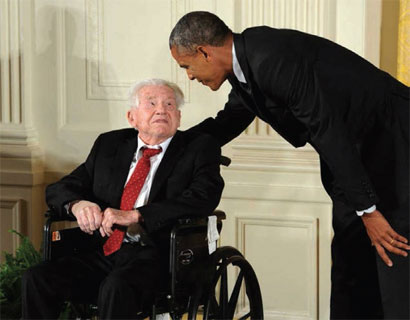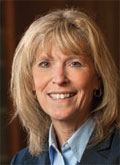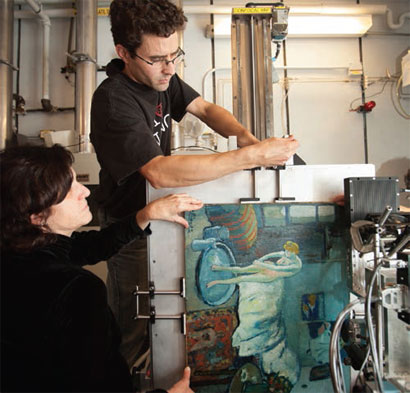
Big Red bash: Past Homecoming festivities have nothing on what’s planned for Cornell’s 150th birthday.
The University is poised to celebrate its 150th birthday with events set to run throughout the 2014–15 academic year. The festivities kick off on Saturday, September 13, with the first in a series of regional celebrations: two showings of a live program entitled “The Big Idea! (Cornell Celebrates 150)” at Jazz at Lincoln Center, with brunch or dinner receptions. They will be emceed by jazz great Wynton Marsalis, NBC news correspondent Kate Snow ’91, and actor and football star Ed Marinaro ’72, BS ’73. Other events will be held in Washington, D.C., Hong Kong, Boston, West Palm Beach, San Francisco, Los Angeles, and London through May. (As of mid-August, tickets to the matinee at Lincoln Center were still available, but the evening show was sold out, with a waiting list.)
A first round of on-campus revelry is planned for Homecoming weekend, October 17 and 18. But the big blowout is set for April 24–27, when Charter Day Weekend marks 150 years since New York State governor Reuben Fenton signed the bill that established Cornell. While the slate of events is still being finalized, its centerpiece will be “Cornell 150: A Festival of Ideas and Imagination,” featuring panel discussions, literary readings, music, and appearances by such esteemed Cornellians as “Science Guy” Bill Nye ’77 and Pulitzer Prize-winner Junot Díaz, MFA ’95. The four-day extravaganza kicks off with a community event at the Tompkins County Public Library and concludes with a Charter Day ceremony in Barton Hall.
In anticipation of the Sesquicentennial, the University is inviting all Cornellians to share memories of their time on the Hill. Go to 150.cornell.edu to upload text, photos, audio, and video for inclusion on the official Sesquicentennial website, which launches in mid-October.

Man of letters: English professor emeritus M. H. Abrams at the White House with President Barack Obama.
Abrams Receives National Humanities Medal
In July, President Barack Obama presented English professor emeritus M. H. Abrams with the National Humanities Medal, which recognizes outstanding achievements in such fields as history, cultural studies, filmmaking, and historic preservation. As the National Endowment for the Humanities noted in its official citation, Abrams was honored “for expanding our perceptions of the Romantic tradition and broadening the study of literature. As a professor, writer, and critic, Dr. Abrams has traced the modern concept of artistic self-expression in Western culture, and his work has influenced generations of students.”
The founding editor of the Norton Anthology of English Literature—a post he held for nearly forty years—Abrams received the medal at the White House a week after his 102nd birthday. His other works include The Mirror and the Lamp: Romantic Theory and the Critical Tradition and The Glossary of Literary Terms. Abrams arrived on campus in 1945 and went on to teach such literary luminaries as critic Harold Bloom ’51 and novelist Thomas Pynchon ’59. He has remained active long after his retirement in 1983. “M. H. Abrams is an inspiration to all of us,” says Arts and Sciences dean Gretchen Ritter ’83. “A renowned scholar and teacher, he has defined the college for generations of students and faculty alike.”
Guide Gives Kudos to CU Food, Daily Sun
A Princeton Review book that rates colleges according to surveys of current students has some kudos for Cornell. The Best 379 Colleges: 2015 Edition puts the University at the number-three spot for both the best campus food and the best campus newspaper; it ranked seventeenth in how much students study. Other findings included scoring ninety-eight out of 100 on admissions selectivity and ninety-four on quality of life. The University received a “green rating” of ninety-nine, the highest score possible. “With so many different colleges within Cornell, there is ‘a plethora of diverse students’ here,” the guide reports, “but the underlying commonality between all students is ‘ambition and ability.'”
Dove Named President of Paul Smith’s College

Cathy Dove, MBA ’84.
One of the prime movers behind the Cornell Tech campus in New York City has left the University to assume the presidency of Paul Smith’s College. Cathy Dove, MBA ’84, who until recently served as the Tech campus’s vice president, is the first woman to lead Paul Smith’s. “For over twenty-five years, and in many capacities, Cathy has made numerous contributions to Cornell—none more significant than her critical role in helping to land and launch our Cornell Tech campus,” says Provost Kent Fuchs. Located in the Adirondacks, Paul Smith’s is known for its programs in forestry, culinary arts, and environmental studies.

Study in style: An architect’s rendering of a crit space in the new AAP NYC facility in Lower Manhattan.
AAP NYC Gets Bigger Digs on Broadway
The College of Architecture, Art, and Planning’s program in New York City will more than double its space when it moves into its new home in Lower Manhattan later this year. The University has signed a ten-year lease to occupy the twentieth floor of 26 Broadway, offering more than 11,000 square feet of studio, classroom, gallery, and lecture space. “The mission of AAP NYC is to offer Cornell design and planning students the opportunity to study complex urban design challenges in situ, so we are delighted to be moving to this spectacular space in a landmark building in the heart of a burgeoning creative community,” says AAP dean Kent Kleinman. “We will have sweeping 360-degree views, natural light for all our studios, and a network of subway connections under our feet.” The program has been housed in its current home in Chelsea since its founding in 2006. The new space—designed by Gensler, a firm founded by Arthur Gensler ’57, BArch ’58—is located in a historic building that’s the former home of Standard Oil.
Synchrotron Helps Reveal Picasso Secret
The Wilson Synchrotron Laboratory’s latest contribution to the art world was revealed last summer, when it was announced that the facility’s X-ray detector had been used to examine a painting beneath a work by Pablo Picasso. Officials at the Phillips Collection in Washington, D.C., revealed that Picasso’s 1901 masterpiece The Blue Room was painted over an image of a contemplative-looking man sporting a beard, jacket, and bow tie. The work had secretly visited campus two years ago for analysis using a state-of-the-art X-ray fluorescence detector known as Maia—a follow-up to earlier infrared imaging elsewhere that had revealed the hidden painting. In September, Jennifer Mass, PhD ’95, a chemist and art conservator at Delaware’s Winterthur Museum who facilitated the painting’s visit to Cornell, will present a paper about the analysis at a scholarly meeting in Paris. Previous CHESS forays into art include scans of works by American painter N. C. Wyeth.

Inside look: CHESS staff scientist Arthur Woll, PhD ’00 (top) and a visiting conservator prepare The Blue Room for analysis.


